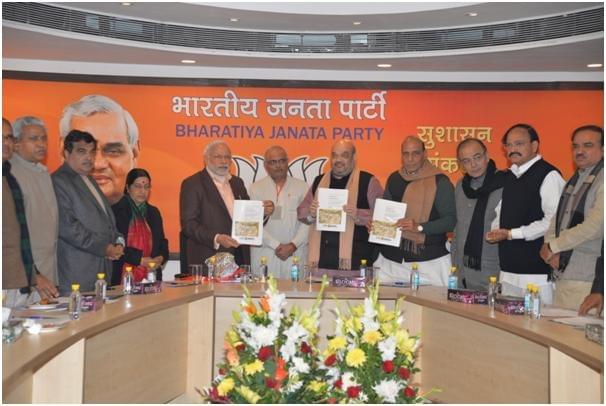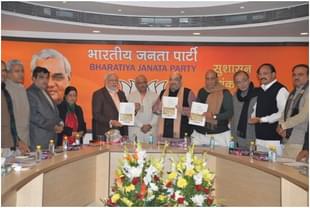Politics
BJP Surveys Governments,Certifies its Own as the Best: I
Sudesh Verma
Jan 15, 2015, 08:11 PM | Updated Feb 18, 2016, 12:07 PM IST
Save & read from anywhere!
Bookmark stories for easy access on any device or the Swarajya app.


An overview of the study,“Politics of Performance — A comparative study of delivery of Good Governance by different political parties in India” conducted by the BJP to assess the performance of various governments.
Being shy is no longer a virtue. In the age of social media where almost everyone wants to show what he or she is doing, one cannot fault the Bharatiya Janata Party (BJP) for flaunting a study to assert its virtuousness. The party has actually thrown a challenge to all other parties to either prove it wrong or accept the model of development followed by it in various states.

The BJP has delivered the best performing governments in the states in recent years and it had also delivered the best performing government at the Centre when the National Democratic Alliance (NDA) was in power 1998-2004, the report of the study released recently by the party and prepared by Public Policy Research Centre has asserted.
Most senior leaders including Prime Minister Narendra Modi and party president Amit Shah were present at the party headquarters on 24 December to release the report. Director of the Centre, Vinay Sahasrabuddhe, who is vice-president of the BJP and has authored the report, was also present.
Till last year, the Bibek Debroy’s study that rated Gujarat high on growth parameters when everyone sought to bracket the state as evil, he had helped create a positive image about Gujarat. His study generated a lot of heat, subjected him to criticisms by the so-called secular critics and led to his resignation from the Rajiv Gandhi Foundation.
In that sense, the Vinay Sahasrabuddhe Report, although brilliant, has failed to generate the same kind of heat. However, if we take away the first-hand impression of the report that could smell of bias, Shahasrabuddhe has done a commendable job. He has used empirical data and unbiased conclusions rather than arguments based on statistical jugglery. This explains why the report places the left-ruled states ahead, when talking of steps taken to curb corruption. In terms of addition of power generation, the Congress-led UPA tipped the BJP-led NDA.
Sahasrabuddhe has years of experience reflecting on good governance. His book, Beyond A Billion Ballots – Democratic Reforms for a Resurgent India, argued strongly for liberating politics from populism. The present study is a continuation of that. Here too, the study argues that populism adopted by regional parties have come in the way of good governance.
Even before becoming the Prime Minister, Modi was keen that a study be undertaken to understand how states run by various parties have performed. He was sure this would create healthy competition among states and persuade them to perform better.
This he called “the ideology of good governance”. The study has been aptly named “Politics of Performance — A comparative study of delivery of Good Governance by different political parties in India”. While the study draws a lot from the growth story of Gujarat, it lauds the achievements of other BJP-ruled states of Madhya Pradesh and Chhattisgarh.
The single focus of the BJP has been to take the good governance debate to the doorsteps of the Opposition and challenge them on bad or non-performance of the states governed by them. The report has spoken of four governance models in the country in the last 67 years post Independence, namely Congress, BJP, Left Front and Regional Parties. “We attempted to compare the performances of these four governance models on the basis of various governance indicators and the resultant socio-economic outcomes,” the report said.
Good Governance is often spoken about as a panacea for all ills plaguing society and government. But there are few who can actually define good governance. Knowing the parameters would facilitate comparison and understanding. The Eleventh Five Year Plan outlined six characteristics of democratic governance:
1.Free, fair and timely elections in all spheres of political authority.
2.Transparency and accountability of all institutions of the state to its citizens.
3.Efficient and effective delivery of socio-economic public services.
4.Effective devolution of authority, resources and capabilities to PRIs and municipalities.
5.Rule of law, where legal rights are clear and understood, and legal compliance and enforcements of those rights is time-bound and swift
6.Needs and interests of hitherto excluded sections of society are privileged and included, with dignity.
The United Nations Economic & Social Commission for Asia and the Pacific (UNESCAP) sharpened the definition and identified eight parameters to define good governance. Probably it marks a shift from governance to good governance. These are:
1.Participation
2.Rule of Law
3.Transparency
4.Responsiveness
5.Consensus Oriented
6.Equity and inclusiveness
7.Effectiveness and efficiency
8.Accountability
Good governance is not a vague concept; it can be measured using these identifiable parameters. Corruption has not been given as an indicator since it is generally believed that all these elements would automatically eliminate corruption. The BJP report has taken perception of corruption as an indicator and has rated the Left Front government high.
The categorisation of different models of governance as Congress, BJP, Left Front and Regional Parties may raise eyebrows. While there are characteristics that help identify and separate one model from the others, there is a lot of overlap. The government is in a state of continuity, kept more so by the bureaucracy that does not change with change of political masters. But the categorisation is interesting and well substantiated.
Congress governments are characterised by socialism and populism, with an inconsistent economic policy, the report says. The BJP’s governance shares certain Gandhian socialist values, but applies and achieves them through more consistent and market-friendly economic policies.
The Left Front [including the Communist Party of India (Marxist) and other left parties] follows a stated Marxist ideology that places the state at the commanding heights of the economy and focuses on worker’s rights and equality of outcomes for all.
Regional parties are described as being more representative of the socio-economic make-up and responsive to particular needs of their states. They are hence more populist and less ideological in their approach, the report says.
At the national level, the Congress and BJP’s models of governance have been delineated and dissected in the context of performance. One would, however, wonder if there is actually an ideological difference based on performance or focus since there is not much difference in style of functioning of the two parties when in power. They used the same bureaucracy, the same logic and even their decisions were incremental.
The NDA though had taken some path-breaking decisions such as four-‘laning’ of national highways, rural roads, telecommunication. In terms of streamlining administration through reforms, both the national parties were equally silent.
Trying to find out differences based on the size of the ministry or decision-making, which the report tries to make, may not be correct since the size is dictated by coalition compulsions and cannot be said to be ideological. Even decision making by Group of Ministers (GoMs) cannot be said to be ideological.
AThat the institution became defunct under the UPA is a factor of style of leadership. Former Prime Minister Dr Manmohan Singh did not have the moral authority since he was foisted from the top by Congress president Sonia Gandhi.
Part II of the explanation of the survey by Sudesh Verma will deal with rule of law, corruption, quality of regulations and laws, ease of business and infrastructure. Part III is about e-governance, populism and size of government.
Sudesh Verma is a senior journalist and president of Debating India Foundation, a Delhi based think tank. He has authored Narendra Modi: The Game Changer, a bestseller on the life and career of the Indian Prime Minister.




